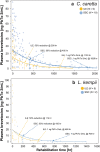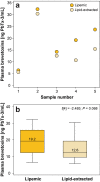Use of intravenous lipid emulsion therapy as a novel treatment for brevetoxicosis in sea turtles
- PMID: 34921188
- PMCID: PMC8683444
- DOI: 10.1038/s41598-021-03550-y
Use of intravenous lipid emulsion therapy as a novel treatment for brevetoxicosis in sea turtles
Abstract
The southwest coast of Florida experiences annual red tides, a type of harmful algal bloom that results from high concentrations of Karenia brevis. These dinoflagellates release lipophilic neurotoxins, known as brevetoxins, that bind to sodium channels and inhibit their inactivation, resulting in a variety of symptoms that can lead to mass sea turtle strandings. Traditional therapies for brevetoxicosis include standard and supportive care (SSC) and/or dehydration therapy; however, these treatments are slow-acting and often ineffective. Because red tide events occur annually in Florida, our objective was to test intravenous lipid emulsion (ILE) as a rapid treatment for brevetoxicosis in sea turtles and examine potential impacts on toxin clearance rates, symptom reduction, rehabilitation time, and survival rates. Sea turtles exhibiting neurological symptoms related to brevetoxicosis were brought to rehabilitation from 2018-2019. Upon admission, blood samples were collected, followed by immediate administration of 25 mg ILE/kg body mass (Intralipid® 20%) at 1 mL/min using infusion pumps. Blood samples were collected at numerous intervals post-ILE delivery and analyzed for brevetoxins using enzyme-linked immunosorbent assays. In total, nine (four subadults, one adult female, four adult males) loggerheads (Caretta caretta), five (four juvenile, one adult female) Kemp's ridleys (Lepidochelys kempii), and four juvenile green turtles (Chelonia mydas) were included in this study. We found that plasma brevetoxins declined faster compared to turtles that received only SSC. Additionally, survival rate of these patients was 94% (17/18), which is significantly higher than previous studies that used SSC and/or dehydration therapy (47%; 46/99). Nearly all symptoms were eliminated within 24-48 h, whereas using SSC, symptom elimination could take up to seven days or more. The dosage given here (25 mg/kg) was sufficient for turtles in this study, but the use of a higher dosage (50-100 mg/kg) for those animals experiencing severe symptoms may be considered. These types of fast-acting treatment plans are necessary for rehabilitation facilities that are already resource-limited. Intravenous lipid emulsion therapy has the potential to reduce rehabilitation time, save resources, and increase survival of sea turtles and other marine animals experiencing brevetoxicosis.
© 2021. The Author(s).
Conflict of interest statement
The authors declare no competing interests.
Figures



Similar articles
-
Emerging Insights into Brevetoxicosis in Sea Turtles.Animals (Basel). 2024 Mar 22;14(7):991. doi: 10.3390/ani14070991. Animals (Basel). 2024. PMID: 38612230 Free PMC article. Review.
-
Dehydration as an effective treatment for brevetoxicosis in loggerhead sea turtles (Caretta caretta).J Zoo Wildl Med. 2013 Jun;44(2):447-52. doi: 10.1638/2012-0163R.1. J Zoo Wildl Med. 2013. PMID: 23805564
-
Potential effects of brevetoxins and toxic elements on various health variables in Kemp's ridley (Lepidochelys kempii) and green (Chelonia mydas) sea turtles after a red tide bloom event.Sci Total Environ. 2017 Dec 15;605-606:967-979. doi: 10.1016/j.scitotenv.2017.06.149. Epub 2017 Jul 6. Sci Total Environ. 2017. PMID: 28693110
-
Brevetoxin exposure in sea turtles in south Texas (USA) during Karenia brevis red tide.Dis Aquat Organ. 2018 Jan 31;127(2):145-150. doi: 10.3354/dao03194. Dis Aquat Organ. 2018. PMID: 29384484
-
Red Tide: Overview and Clinical Manifestations.J Allergy Clin Immunol Pract. 2020 Apr;8(4):1219-1223. doi: 10.1016/j.jaip.2019.10.030. Epub 2019 Nov 21. J Allergy Clin Immunol Pract. 2020. PMID: 31761688 Review.
Cited by
-
Emerging Insights into Brevetoxicosis in Sea Turtles.Animals (Basel). 2024 Mar 22;14(7):991. doi: 10.3390/ani14070991. Animals (Basel). 2024. PMID: 38612230 Free PMC article. Review.
References
-
- Baden DG. Brevetoxins: unique polyether dinoflagellate toxins. FASEB J. 1989;3:1807–1817. - PubMed
-
- Landsberg LH. The effects of harmful algal blooms on aquatic organisms. Rev. Fish. Sci. 2002;10:113–390.
-
- Fauquier DA, et al. Brevetoxin in blood, biological fluids, and tissues of sea turtles naturally exposed to Karenia brevis blooms in central west Florida. J. Zoo Wildl. Med. 2013;44:364–375. - PubMed
Publication types
MeSH terms
Substances
LinkOut - more resources
Full Text Sources

